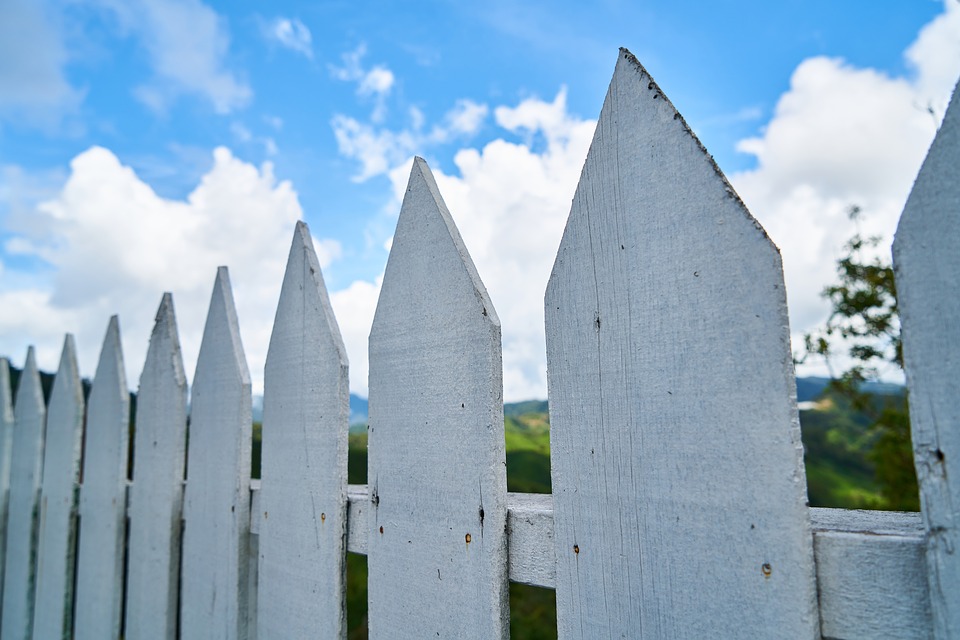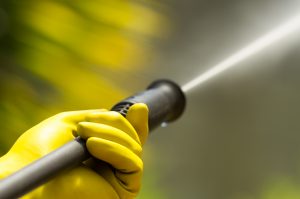Painted or varnished, wood fencing is timeless and can add a lot of character to your garden. To keep your wood fence looking as good as new will require some maintenance though. Some of the most important maintenance tasks for wood fencing include cleaning and repainting every once in a while. While fence maintenance might seem easy, you should know how to do it properly. Using the wrong cleaning techniques for a wood fence could cause the wood to crack or warp, so it’s important to know how to clean a wood fence the right way.
Wood Fence Problems: Maintaining Your Wood Fence
Unlike plastic or steel, wood is a plant-based material. The fact that it’s derived from an organic source makes it prone to rot and other forms of decomposing. After all, in nature decomposition of dead organic matter is necessary and helpful. This doesn’t mean that wood isn’t durable, but it takes extra effort to preserve its condition when compared to other materials. Wood can rot, mold, crack and fade quickly when not cared for properly.
When dealing with warm, humid climates (which are often found close to the sea) it’s especially important to clean your wood fence regularly. Cleaning will prevent mold growth and rot.
But while humid weather can cause rot, excessively dry conditions will make your fence to crack and become dusty more quickly. Dust is a sore eye and can mask more serious problems, like cracks.
Hot, sunny conditions also tend to be an issue for wood fencing. UV damage can cause your wood and finishes to fade more rapidly. To fix this, you’ll need to redo the finish on your fence annually or bi-annually. If you’re wondering when you need to repaint, simply check if your current finishing is faded, scratched, chipping or coming off.
When your finishing starts to create bubbles, it’s sign that the wood underneath has absorbed moisture. Don’t leave your fence if you see bubbles in the finishing. Waiting will only cause the wood to start rotting more, in which case you might need to replace your fence all together.
The best way to keep track of the condition of your fence is simply to clean your wood fencing regularly. You’re sure to spot potential issues during cleaning that demand your attention.
How to Clean a Wood Fence Yourself
To clean your wood fence yourself, you will need a wire brush, fence cleaner, garden hose and a soft plastic brush.
For a wood fence cleaner, you can use a commercial product specially designed for cleaning wood decks and fences. Alternatively, you can use oxygenated bleach (dilute according to manufacturer instructions) for a homemade solution. If you want a more natural solution, you can dilute vinegar in water, although this is unlikely to be as effective as other options.
Step 1: Preparing Your Fence
To start cleaning your wood fence, use your wire brush to remove large dried clumps of mud and other debris. Be careful when brushing. Don’t apply too much pressure, as this can scratch and damage the surface of your fence.
Once there are no more clumps of debris on your fence, use your garden hose to rinse it well. Also check for spiderwebs during this stage and rinse them away where possible.
Step 2: Apply a Wood Fence Cleaning Solution
Now that your fence is ready, you can apply your fence cleaning solution. If you’re using oxygenated bleach, apply it all over your fence with a large paint brush. Wait 15 minutes for it to work.
If you’re using a specialized wood deck and fence cleaner, use according to the manufacturer’s guidelines. You should be able to buy a specially formulated wood deck and fence cleaner from your local hardware store.
If you opt for the eco-friendly vinegar and water option, you can make your mixture with half a cup of vinegar diluted in a gallon of water. Use a larger ratio of vinegar to water if your fence is particularly dirty. To wash your fence, apply the mixture using a sponge. Wait 15 minutes.
Step 3: Brush the Fence Down
After waiting for 15 minutes to let your cleaning solution work, it’s time to scrub it. Use your plastic bristle soft brush and thoroughly scrub your fence all over. You can use a bucket of water to dip your brush occasionally while you scrub.
Check your fence for mold, stains and other dirt while scrubbing. Focus on these areas to make sure your fence is properly clean.
To protect yourself, always wear a protective mask while cleaning mold. A gas mask will work best, as it will ensure you aren’t breathing in any spores. Some forms of mold can be very dangerous to your health.
When working with bleach and other harsh chemicals, you should also wear protective gloves. Wear your protective gloves throughout the process, both while applying your solution and while scrubbing the fence.
Step 4: Hose Down with a Hose Pipe
Once you’re satisfied that you’ve covered all the different areas on your fence, it’s time to rinse it down. Rinsing will remove the cleaning solutions and dirt that remain on your fence after scrubbing.
Simply use your hose pipe with an adjustable nozzle that allows you to control the water pressure, or a spray gun attachment. Just make sure you have high enough pressure to properly rinse down the residue left on your fence.
After the final rinse, check your fence again for any remaining stains or mold. Spot treat problem areas with more cleaning solution and repeat the process for these areas.
Pressure Cleaning a Wood Fence
If manually cleaning your wood fence seems like too much effort, why not try pressure cleaning? The benefit of pressure cleaning is that pressure washing your wood fence will blast away dirt quickly and effortlessly compared to manual cleaning. A downside of pressure cleaning is that it can be dangerous. The water beam from the pressure washer nozzle is powerful enough to injure you or damage your fence.
To avoid injury or damage, it’s best to call in a professional power cleaning service to clean your wood fence. Professionals are quick and efficient. As an added bonus, you won’t need to spend your free time doing maintenance work. If there are any other areas around your house that need cleaning, such as your driveway, deck or sidings, you can have the pressure washing company clean them too.
Ask your power cleaning company what cleaning solution they use. If your fence is close to your garden or grassy areas, you’ll need to prevent cleaning chemicals from damaging your garden. One option is to cover your garden with a waterproof plastic cover, although this might not entirely prevent damage to your plants. Another way is to ask your power cleaning company to use eco-friendly cleaners that aren’t damaging to your plants.
Cleaning a Wood Fence before Repainting
You might’ve heard that it’s important to clean your wood fence or deck before repainting it. This is true. Once your fence is clean, you need to sand down the current finishing to remove it before you paint again.
You can also remove paint using a paint remover. Ask an assistant at your local hardware store for a paint remover that’s best suited for wood surfaces. To use paint remover on wood, apply a thick layer of remover with a large, inexpensive paint brush. Wait for about 20 minutes, or until the paint begins to bubble, then use a scraper to gently scrape it off without damaging the surface of the wood.
Another method of removing finishing is with a heat gun. For this method, you will need a heat gun. Follow the instructions of the heat gun manufacturer for how far you need to keep it from your fence. Once you’re done with the heat gun, you’ll need to scrape the fence. Unfortunately, this method is dangerous, so you’ll have to be careful to avoid burning yourself.
Even if you use a paint remover or heat gun, you might still have to sand down some of the finishing that remains once you’re done.
There are multiple ways you can clean your fence for great results. While one way isn’t necessarily better than another, there are ways that are certainly easier. When deciding how to clean your wood fence, consider factors such as how much time you’re willing to spend and your budget. When deciding what cleaning solutions are best, consider the state of your fence. If you have lots of mold, a bleach solution or wood deck and fence cleaner is best. However, if you have a garden, you’ll need to protect it. Consider using a cleaner that’s not damaging to your plants.


